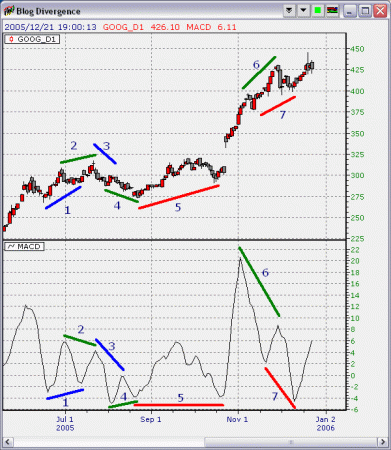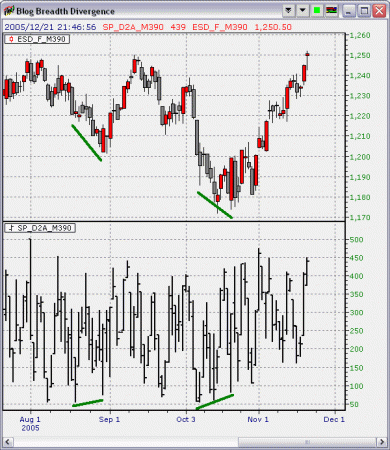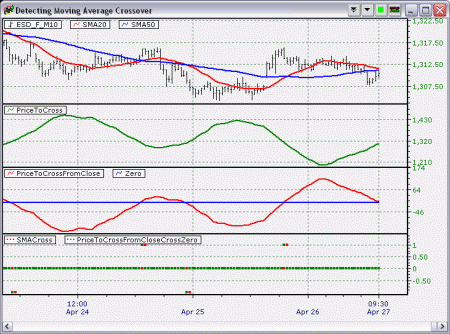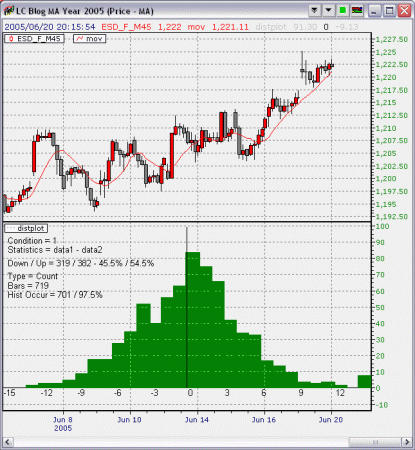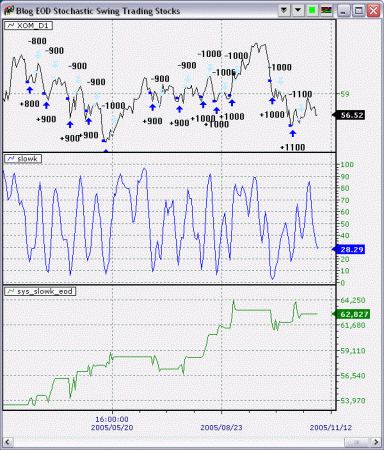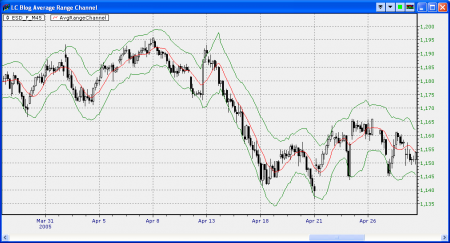Basic Chart Reading – What is Divergence Anyway?
Since the first Basic Chart Reading article was written, I received many emails asking the fundamental question, “What is Divergence?”. I will try to explain what I know about this concept, hopefully, as precise as possible.
Divergence is About Comparison
Divergence is a chart formation. Its about comparison. It is the comparison of the data we want to analysis against something else. The interesting part is, you cannot talk about divergence unless you properly define the two items you are making the comparison.
The most common comparison pairs are,
Price Series vs. Moving Average Convergence Divergence (MACD)
Price Series vs. Stochastics
Price Series vs. Relative Strength Index (RSI)
Price Series vs. Rate of Change (ROC)
Price Series vs. Some Other Oscillators
Price Series vs. Another Price Series (e.g. TICK index)
Price Series vs. Anything That Can Be Charted!
I am going to use MACD as the example to show the various divergence combinations as it is one of the most common indicators.
Confirmed Moves
Here is a chart of Google with MACD using simple moving average of 8 and 13 period.
I have marked the chart with various setups so that we can reference to various setup in the chart easier.
First, I am going to talk about confirmed moves.
In a trending market that is going up, the price series is expected to swing with higher lows and higher highers.
In a trending market that is going down, the price series is expected to swing with lower highs and lower lows.
When the indicator or the data series you are comparing against is doing exactly the same thing as the price series in the trending market, you have confirmed moves.
Lets take a look at the confirmed moves in the example chart.
Formation #1 is a confirmed higher lower. Both the price series and MACD are making higher lows, that tell you the price movement is confirmed and no weaknesses in the price movement is detected. This is a confirmed move and no divergence is detected.
Formation #3 is a confirmed lower high. That means, the price is making a lower high while the MACD is doing the same. It is called a confirmed movement and no divergence is detected.
Divergence Resulted from Non-Confirmation
The chart setup at #2 and #6 are examples of non-confirmations. The higher high in price does not result in the higher high in the MACD. Instead, the MACD is making a lower high, that is a warning sign that the new high in price is not sustainable.
The chart setup at #4 is another example of non-confirmation. The lower low in price is not confimed by a lower low in the MACD. That means the price movement could be exhausted and a bounce is likely.
For the setup #2 and #6, they are often called bearish divergence.
For the setup #4, it is often referred as a bullish divergence.
Divergence Resulted from Over-Confirmation
Lets take a look at the setup #5 and #7, both of them are examples of over confirmation. That means, the prices are making higher lows while the MACD is making double bottom or lower lows.
Divergence setups based on over-confirmation are usually continuation patterns. That means, if a market is trending in a particular direction, the over-confirmation setups usually mark the resumption of the original trend.
Many chartists do not consider this type of chart setup in the same category as the classic non-confirmation type divergence.
Using Divergence Setups
In short, we use divergence setups to catch the end of a trending move in the price series, nothing more.
Divergence setups sometimes mark the change in trend, but not all the times. Most of the time, divergence setups simply identify the start of consolidation after a strong trending move in the price series.
Thus, in order to pick top or bottom, using just divergence is not enough. You need other confirmation signals to improve the odds.
Mixed Signals
Most of the time, we see mixed setups develop in the price series. Confirmed higher lows with higher highs divergence with MACD. Or, confirmed lower highs with lower lows divergence with the TICK index. To determine the importance among the setups is more an experience issue then mechanical rules.
As a rule of thumb, however, it is quite useful to look at higher time frames for better identification of the trend factor. For example, if the higher time frame is clearly showing a down trend with confirmed moves from your indicators. Then in the lower time frame where you seek for the entry signal, you would read the chart in a more bearish manner. Thus, you probably will take the bearish divergence setups more seriously then the confirmed higher lows.
An Example of Divergence Reading Based on Market Breadth
Here is a chart of daily Emini S&P compared against the S&P 500 2-Day Advance Issues customized breadth data.
This chart showed an important concept about divergence detection – if the indicator or data series used for comparison is not directly correlated to the price series, the divergence setups will be more significant and stronger than the ones purely derived from the data series.

